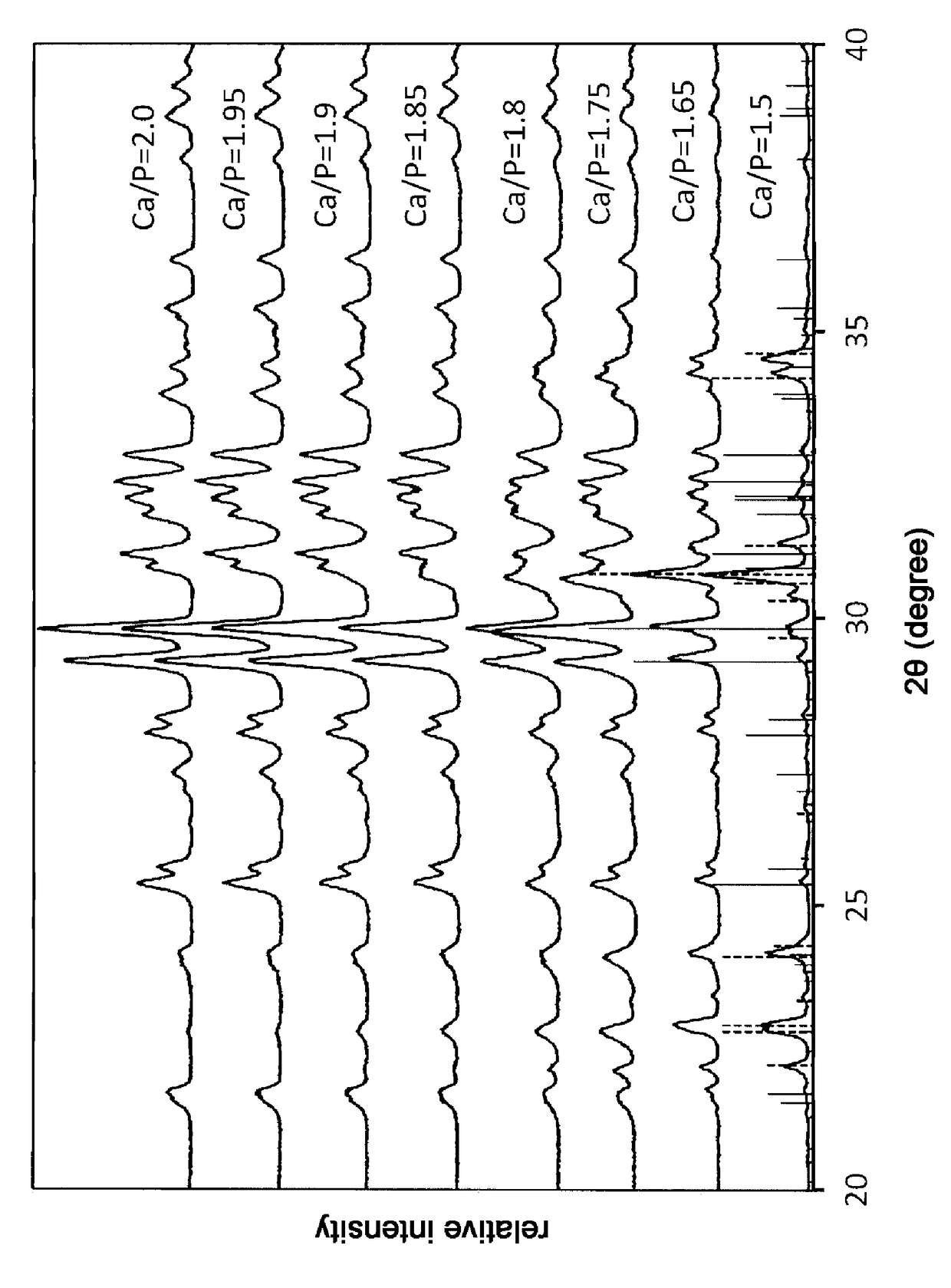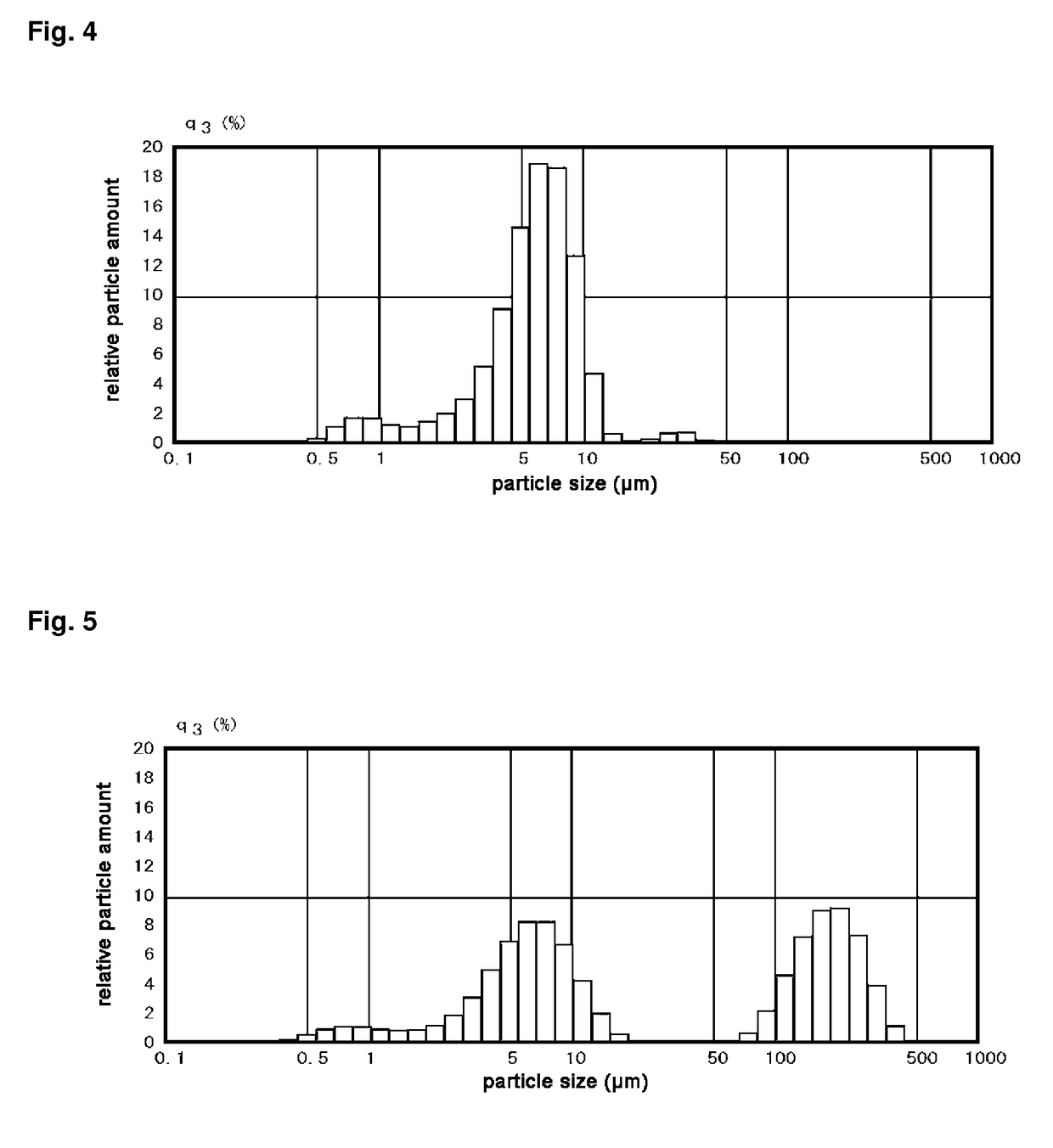Method for controlling work time for forming shape of biphasic self-setting calcium phosphate
a self-setting calcium phosphate and work time technology, applied in dental prosthesis, impression caps, prosthesis, etc., can solve the problems of not specifically describing the non-stoichiometric ttcp, not knowing how much the setting time of the kneaded material containing the biphasic sscp powder portion is, and not knowing the shape of the non-stoichiometric ttcp, etc., to achieve excellent shape formability, easy to form shape shape
- Summary
- Abstract
- Description
- Claims
- Application Information
AI Technical Summary
Benefits of technology
Problems solved by technology
Method used
Image
Examples
reference example 1
Method for Producing TTCP / α-TCP Solid Solution
[0392]CaCO3 and DCPA are put in a general-purpose oven and heated for 2 to 3 hours at a temperature of 105° C. to dry the CaCO3 and DCPA.
[0393]Next, the dried CaCO3 powder and DCPA powder are allowed to stand still in a vacuum desiccator and cooled.
[0394]The mixing ratio of the TTCP / α-TCP to be obtained can be adjusted by adjusting the mixing weight ratio of CaCO3 to DCPA as shown in Table 1 described above. In the case of Example 1, a case of using 349 g of CaCO3 and 651 g of DCPA will be described.
[0395]In this case, the weight % of the CaCO3 based on the sum of the weight of the CaCO3 and the weight of the DCPA is 34.9 weight %.
[0396]The CaCO3 and DCPA are put in a 4000 mL graduated beaker (252 mm in height and 161 mm in diameter).
[0397]Next, 3000 mL of distilled water is poured into the graduated beaker, and then a dispersion of the mixture is stirred for 6 to 7 hours at rate of about 300 rpm using an overhead stirrer equipped with a...
reference example 2
[0413]In the case of Reference Example 1, the resulting TTCP / α-TCP solid solution was ground by a dry grinding step to obtain a uniform powder.
[0414]On the other hand, Reference Example 2 is different from Reference Example 1 in that the TTCP / α-TCP solid solution was ground by a wet grinding step to obtain a uniform powder.
[0415]By the same operation as in the case of Reference Example 1, a coarse powder and a small block among the contents of the crucibles are put in a blender (manufactured by Waring Corp., a heavy-duty blender for laboratories, model number: 38BL52 (LBC10)) and ground for 20 seconds.
[0416]The contents of the blender are removed, transferred to a stainless steel sieve with 8 inches in diameter having an opening width of 420 μm, and manually sieved.
The grinding step using the blender and the sieving step are repeated until a sufficient amount of powder is obtained.
[0417]Next, 100 g of the powder passed through the sieve is put in an agate jar having a capacity of 35...
example 1
[0423]A biphasic SSCP liquid portion was prepared by adding 3.3 g of distilled water and CaO (available from Wako Pure Chemical Industries, Ltd., hereinafter the same) to 10 g of a phosphoric acid aqueous solution having a hydrogen ion concentration of pH 2.1 so that, in the biphasic SSCP liquid portion, the concentration of phosphorus was 2.96 mol / L and the concentration of calcium was 1.09 mol / L.
[0424]Further, trisodium citrate was added to the biphasic SSCP liquid portion in such a proportion that 1 mol of trisodium citrate and the biphasic SSCP liquid portion were combined into a total volume of 1 L.
[0425]Next, a biphasic SSCP powder portion having a molar ratio of calcium to phosphorus (Ca / P) of 1.81 obtained by the same production method as in Reference Example 1 was weighed in an amount of 3.0 g and kneaded with 1.0 g of the biphasic SSCP liquid portion using a spatula.
[0426]Note that, in the present invention, the powder-liquid ratio means the weight ratio of powder to liqui...
PUM
| Property | Measurement | Unit |
|---|---|---|
| Temperature | aaaaa | aaaaa |
| Temperature | aaaaa | aaaaa |
| Fraction | aaaaa | aaaaa |
Abstract
Description
Claims
Application Information
 Login to View More
Login to View More - R&D
- Intellectual Property
- Life Sciences
- Materials
- Tech Scout
- Unparalleled Data Quality
- Higher Quality Content
- 60% Fewer Hallucinations
Browse by: Latest US Patents, China's latest patents, Technical Efficacy Thesaurus, Application Domain, Technology Topic, Popular Technical Reports.
© 2025 PatSnap. All rights reserved.Legal|Privacy policy|Modern Slavery Act Transparency Statement|Sitemap|About US| Contact US: help@patsnap.com



